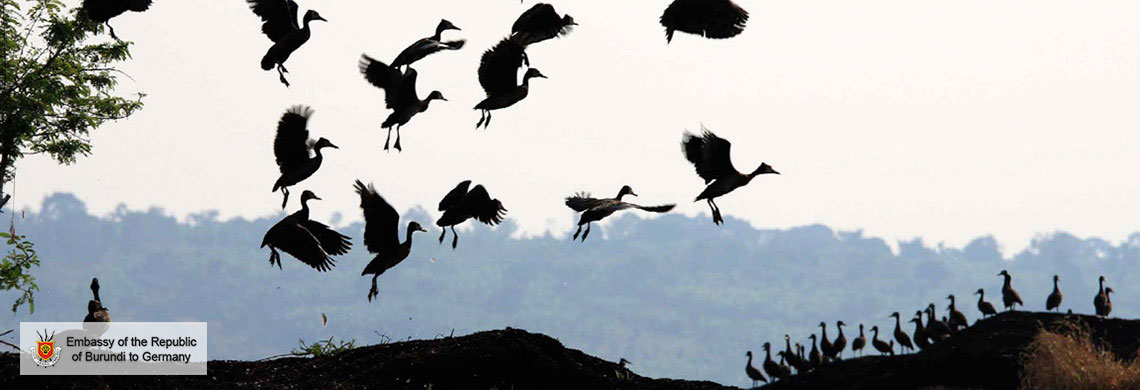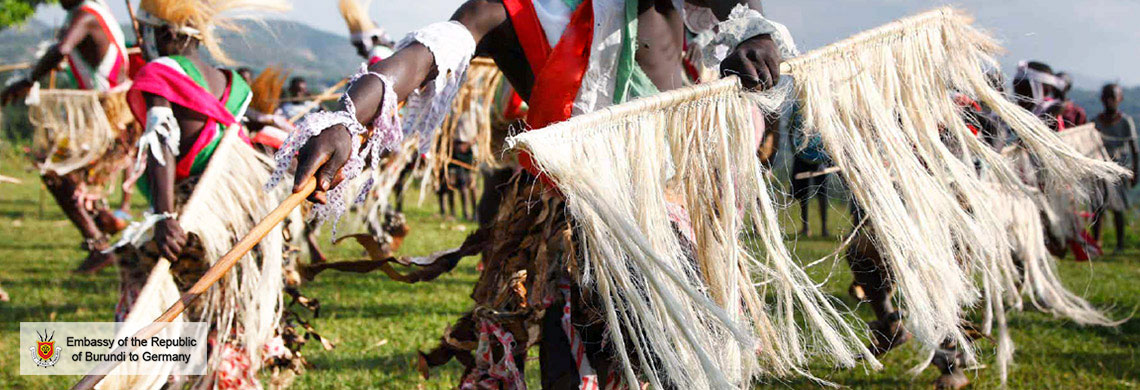Business Information

Business Information
Economy
A. Agriculture
The burundian economy is mainly grounded on agriculture. Statistic estimates indicate that 90% of the population relies on agriculture combined with livestock for the livelihood. There are two types of crops cultivated: Food crops (beans, bananas, sweet potatoes, cassava, maize and sorghum) and cash crops (coffee, tea, cotton and quinquina). Agriculture generates value-added estimated at about 58% of gross domestic product and produces most the foreign exchange coming into the country. It should be noted that coffee (Arabica and Robusta accounts for nearly 90% of the country’s export earnings and that plantations remain, for the most part village enterprises. The tea produced in Burundi is high quality. The tea crop contributes to poverty alleviation in Burundi because 95% of its production is exported. Burundi plans to increase the tea production by privatizing some complexes of production and by increasing the area of cultivation. Cotton constitutes the third traditional produce for export. Burundi cotton is a highly appreciated produce because of its quality. Burundi plans to increase the export offer by extending its growing area to the Imbo and Moso regions. The main food crops are: maize, sorghum, sweet potatoes, banana, beans, cassava, taro, palm oil, meat, etc.Livestock farming contributes 3% of gross domestic product.
B. Fishing
Burundi is boarding the Lake Tanganyika which is known in the world to be a lake containing a lot of fish of different varieties. The national production is estimated to 15,000 tones. The artisan fishing contributes to 90% and the development of the industrial fishing should enable the country to have an exportable surplus. The identified products for export are the frozen and smoked fishes, the ornamental alive fishes and the crabs. The fishes know as “INDAGALA” are the unique species found only in the Lake Tanganyika, and this offers a considerable advantage for export.C. Livestock Farming
In the past, the cow was less an animal than an institution; cattle were not regarded from the utilitarian angle, as a factor in the economy but as status symbol. The size of the herd was an index of the individual’s wealth and social status.Livestock rearing is not well integrated into farming and remains essentially extensive in nature. At the present time, research is proceeding with strategies for reconstituting livestock herbs and the genetic improvement of animal breeds.
An integrated herd reconstitution program will be established, and will include highly prolific, short-cycle small livestock that will yield a quick improvement in rural family incomes. This kind of livestock is also more suitable to agro-sylvo-pastoral integration. Improving rural incomes will also require the promotion of cottage industries and handicrafts that will create non-farm employment and will also help to reduce imports. This subsector is currently very underdeveloped, from all points of view, and will require efforts involving training, extension work and financing. As a first step, handicrafts associations will be organized and established through the provision of credits; productive units that were destroyed during the crisis will be rehabilitated; and a handicrafts support fund will be established.
The quality of the cattle herd will be improved by crossbreeding with highly productive stock. This will be done primarily through semen imports followed by an artificial insemination program, which is likely to produce better results than importing animals that are not adapted to local climatic conditions. Veterinarians from the extension services will train communities to install and manage insemination centers.
Herd management techniques will be improved, particularly through permanent stabling for heavy livestock, swine and poultry, so as to make better use of harvest residues and enhance animal productivity in terms of livestock products and organic fertilizer.
Efforts to intensify livestock productivity will not be successful without proper feeding conditions, in terms of forage and concentrates. Forage crops will therefore be encouraged. In particular, attention will be given to herbaceous and woody legumes, which will not only provide high-quality forage but will enhance soil fertility as well. In the short term, seeds will have to be imported for species that have already been tested by ISABU. The emerging seed industry will also have to produce forage seeds that can be multiplied, in due course, by farmers’ associations and cooperatives. These associations will also have to see to the growing of legumes and cereals for producing concentrates.
In order to take full advantage of intensive livestock grazing, a sustained effort will be required to prevent and treat the most frequent and serious diseases. In the short run, purchase of the required inputs will have to depend on government agencies and donors. Responsibility can then be transferred gradually to communities and private operators, as associations and producers receive the required training.
D. Mineral and Mining
Burundi has considerable mining deposits to be mentioned considering their reserves and contents:- Mining deposit of Nickel of which the considerable reserves contain also very interesting associated metals by their content (copper, cobalt, platinum metal group)
- Deposit of Iron-Titan-Vanadium -- this is the best mining deposit in world considering its reserves and high content
- Deposit of Bastnaesite very rich in Europium
Recent seismic and magnetic surveys have indicated that there may be Oil under Lake Tanganyika and the Rusizi river plam.
Source: Ministry of Energy and Mines
Economic Reforms
Burundi has been involved, for more than 20 years, in economic reforms with the help of the Bretton Woods institutions. However, the positive results which were becoming more and more significant were harmed by the 1993 crisis. Although the crisis persisted, the economic reforms were curried on with the help through a minimum humanitarian assistance by the World Bank, and few other partners.A. Legal and institutional reforms of affairs
To attract both national and foreign direct investments, Burundi has reviewed its code of investments in most of its main core. The procedures of enterprise approval as a priority enterprise have been simplified. Furthermore, some measures of the investment code have been reviewed in function of the evolution of the foreign exchange policy change which has been simplified. It is also the concern of simplifying the approval and adaptation procedures to the new exchange policy that has motivated the promulgation of the law nº1/15 of 31 July 200 modifying the statutory order nº1/30 of 31 august 1992 related to the creation of a free trade Area Regime in Burundi.Related texts:
- Burundi Free Trade Regime/Free Zone
- Investments code
- Trade code
- Fiscal code
- Law on insolvency and promotion of enterprises/Dispositions générales du code des Sociétés publiques et privées.
B. Trade liberalization
Burundi has adopted the trade liberalization policy specially by abolishing quantitative restrictions to imports, by instituting the freedom of fixing prices and by observing the right to negotiate with the private sector the price structure of a very limited number of strategic products for the national economy in respect of WTO and COMESA rules and regulations. This is specially the case for oil products and sugar.In the banking sector, the State has been oriented since some years towards the free exercise of this activity and towards a progressive disengagement in the social capital of banks. This policy has favored the creation of many new banking to the great benefit of customers.
C. The monetary and exchange policy
The monetary authority applies a rigid monetary policy to sustain a weak inflation rate. It relies mainly on the target of the growth of the money through the imposition of upper limits refinancing to the financial institutions. The refinancing interest rate is periodically adjusted by considering the underlying inflation rate.The government gives also a lot of importance to the abolition of the difference which persists between the official change rate and the rate in the parallel or informal market which is a serious threat to the efficient affectation of currencies. In the short term the monetary authority intensifies its efforts for improving the operation of the exchange market. With this respect, it is fortunate to note that the unification policy of the exchange rates has already led to a reduction between the two rates which went from 30% to 17%. In order to reduce more this gap, the Government of Burundi has started to liberalize completely the exchange policy particularly through the authorization of free opening of the “private forex bureaux.”
All the products are in fact eligible to importation except the legal prohibitions and there is no required deposit before importation. The financial transfers such as rental revenues, education and jobs’ bonus, traveling fees, foreigners’ economies done before leaving the country are completely liberalized.
Moreover, the monetary authority is determined to maintain the floating exchange rate system which would lead to fluctuation of the exchange rates according to the evolution of the supply and demand of currencies. It is in this context that the monetary authority has adopted a dynamic approach in its management of the market for currency auction installed in June 2000. To facilitate the commercial banks operations, the obligation of currencies transferring is not more applicable to non traditional experts while the obligation of currencies retrocession applied to traditional exportations (cotton, tea and coffee), will be reduced fro 70% to 50% by the end of December 2003.
D. The Budgetary policy
With the support of the Monetary Fund and the World Bank, the government has adopted a transparency policy in its program of modernization of the public finance management and the means of its implementation.The classification of public expenses per nature has been revised in order to facilitate the move from the expenditures based accounting to the public accounting. The inventory of the state’s arrears and those due to the state have allowed a better allocation of resources affected to the internal and external debt service. The introduction of the new procedures of the budget implementation allowed a better follow-up for all the implementation phases as well as the comparison between the administrative and the general accounting. Finally the execution of the State’s budget will be soon audited by the revenue Court for which the project of its creation is in the National Assembly for adoption.
E. Customs Reform
In order to improve the efficiency of customs’ administration and to increase its output, Burundi has decided to reduce the rates of customs duties at importation. The tariff peaks have been eliminated to favor the moderate rate of 40% which will be the highest rate. In addition, the tariff lines have been reduced to only four (10-12-15-40). Furthermore, taking into account the COMESA environment, Burundi has adopted the COMESA nomenclature based on the Harmonized System (HS) 1996 version and is prepared for the application of tariff zero system in 2004 for all the products from the COMESA Region as well as the application of external common tariffs.F. Fiscal Reforms
The on-going fiscal reforms aim at the modernization and simplifying of the legislation in order to increase the efficiency of the fiscal administration and to take into account the commitments made in the context of COMESA. For this effect, the revision of the general tax code and duties is in progress and should let come out a reduction of the imposition rates and the replacement of the Transaction Tax by Tax on the value Added. Finally, the setting-up of the unique identification to make an inventory of all the taxpayers should allow a broadening of a tax base by a better imposition up to the informal sector. This action should be accompanied by an elaboration of a fiscal procedures’ box for the taxpayers.G. Privatization of Public Enterprises
Since 1986, the government has adopted a program of disengagement in the public investment to the advantage of private initiatives. The program continues with the enterprises that remain, and that are, generally, considered as investments with big capitals and therefore difficult to privatize because of the internal weak savings. However, it seems that the sector of services is easier to privatize than the industrial sector, probably because of its profitability which is much higher and without competition. The Interministerial Committee of Privatization (ICP) and the Service in chargé of Public enterprises (SPE) have already established a program of disengagement of the State in all sectors.H. The private sector development policy
The policy of the private sector development has been initiated with the beginning of the structural adjustment program of which it is one of the components. This policy which was backed by the Breton Woods institutions and the UNDP is made of two main elements including the public enterprise privatization policy and the private sector promotion.Actually many public enterprises have been either privatized or liquidated. They are no more a burden for the public treasury. This policy will continue until the total withdrawal of the government in the profit oriented enterprise management. Concerning the private sector promotion, many structures have been created at this end and many studies have been carried out to promote the sector.
Many research studies have been made by the Policy Coordination Unit for the Development of the private Sector (PCUDPS) and have given prominence to the need of boosting the commercial and industrial activities sin modernizing the production tools and in exploiting some boosting channels for exports. The Government is preparing on the basis of these results an action plan to be integrated in the Strategic Plan for poverty alleviation.
I. Struggle for poverty alleviation
The elaboration process of Interim Strategic Plan of Poverty alleviation (ISPPA) has been started in July 2000. Its implementation has begun in 2003 by the integration of priority axes in the Finances Act of 2003, as well as in the projects and programs supported by sponsors. Again, the weight of social expenses has increased from a GDP (Gross Domestic Products) of 4.3% in 2002 to 5.3% in 2003. Their part will continue to increase for some time in order to achieve the objectives of the Strategic Plan for Poverty alleviation (SPPA).With the help of the World Bank, the Government has initiated a review exercise of public expenses since 2002. This exercise will be realized periodically in order to constantly rationalize the affection system of the public resources according to the priorities of the SPPA and its Social Program of Urgency (SPU) in order to improve the effectiveness and the expense profit, to the profit of Poverty Alleviation. In this context, the Government is setting up an automatic mechanism to follow up the public expenses in general and the social expenses in particular (tracking). Today, the allocation for foreign aid is based on the priorities of SPPA.
In the short term (2003-2006), Burundi has convened with the IMF an Economic and Financial Program for the Structural economic cooperation which will be financially supported by a Facility for Poverty Alleviation and Growth (FPAG). This program will enable the opening up of more broaden concessionary financings to other donors and to facilitate the mobilization of promised aids during the 2 last table Rounds (Paris, Geneva I and II). The aimed objectives for the next program are:
- To boost the growth rate to about 5%;
- To increase the public expenses reserved to the health and education to the GDP of 5,3% in 2003, of 6% in 2004 and of 7% in 2006;
- To lower the inflation annual rate to 4,5%;
- To maintain the change reserves at around 4 months of importations of none factor goods and services;
- To maintain the deficit of the external current account to a level that can be financed by high confessionals donations and loans;
- To sensibly reduced the outstanding discounted and the ratios of the debt service.
- Find a consensual arrangement on the outstanding and the African Bank for the Development (ABD) and the African Fund for the Development (AFD) current expiration date; this arrangement will include the implementation of payments when due and the discussions with the ABD the restructuring of pocketbook and the programming of the outstanding so as the financial flux become again positive in favor to Burundi;
- To make a preparatory technical work on the necessary debt data at the initiative of Poor Countries Heavily in Debt (PCHD) and negotiate nearby the partners so that Burundi gets to the decision point since the adoption of Facility for Poverty alleviation and Growth (FPAG) by the IMF Board.
J. Audit Office (Cour des comptes)
Please click here to view the Audit laws and regulations.K. Main Economic Indicators of Public Enterprises, 2002
(In millions of Burundi Francs, unless otherwise indicated)| Public Enterprises | Equity participation (In percent)2 | |
|---|---|---|
| 1. | AIR BURUNDI | 100 |
| 2. | APEE (Agences de Promotion des Echanges Extérieures) | 54 |
| 3. | BBCI (Banque Burundaise pour le Commerce et l’Investissement) | 10 |
| 4. | BCC (Burundi Coffee Company) | 60 |
| 5. | BPB (Banques Populaires du Burundi) | 15 |
| 6. | COGERCO (Compagnie de Gérance Cotonnière) | 100 |
| 7. | COTEBU (Complexe Textile de Bujumbura) | 100 |
| 8. | ECOSAT (Encadrement des Constructions Sociales et Aménagement des Terrains) | 100 |
| 9. | FDC (Fonds de Développement Communal) | 40 |
| 10. | FOSIP (Fonds de Soutien à l’Investissement Privé) | - |
| 11. | FPHU (Fonds de Promotion de l’Habitat Urbain) | 83 |
| 12. | Hôtel Source de Nil | 54 |
| 13. | INABU (Imprimerie Nationale du Burundi) | 100 |
| 14. | Hôtel NOVOTEL | 51 |
| 15. | OCIBU (Office des cultures Industrielles du Burundi) | - |
| 16. | ONAPHA (Office National Pharmaceutique) | 100 |
| 17. | ONATEL (Office National des Télécommunications) | 100 |
| 18. | ONATOUR (Office National de la Tourbe) | 100 |
| 19. | OPHAVET (Office Pharmaceutique Vétérinaire) | 100 |
| 20. | OTB (Office du Thé du Burundi) | 100 |
| 21. | OTRACO (Office des Transports en Commun) | 100 |
| 22. | REGIGESO (Régie de Distribution d’Eau et d’Electricité) | 100 |
| 23. | SBBF (Société Burundaise de Banque et de Financement) | 36 |
| 24. | SETEMU (Services Techniques et Municipaux) | - |
| 25. | SIP (Société Immobilière Publique) | 88 |
| 26. | SOBUGEA (Société Burundaise de Gestion Aéroportuaire) | - |
| 27. | SODECO (Société de Déparchage et de Conditionnement du Café) | - |
| 28. | SOGESTAL KIRIMIRO | 68 |
| 29. | SOGESTAL3 MUMIRWA | - |
| 30. | SOSUMO (Société Sucrière du Moso) | - |
| 31. | SRDI (Société Régionale de Développement de L’Imbo) | - |
| 32. | SRDR (Société Régionale de Développement de Rumonge) | - |
Source: Service Chargé des Entreprises Publiques (SCEP)
Major Banks, Financial Institutions, Insurance Companies and Business Contacts
I. Banks
Banque de la République du Burundi (BRB)Tel (257) 225142
Fax (257) 223128
Banque de Gestion et de Financement (BGF)
Tel (257) 221352
Fax (257) 221351
Banque Burundaise pour le Commerce et l'Investissement(BBCI)
Tel (257) 223328
Fax (257) 223339
Interbank Burundi (IBB)
Tél: (257) 220629
Fax: (257) 220461
Banque Commercial du Burundi(BANCOBU)
Tél: (257) 222317
Fax: (257) 221018
Binalease Bank
Tel: (257) 243206
Fax: (257) 243207
Banque de Crédit de Bujumbura (BCB)
Tél: (257) 222091
Fax: (257) 223007
Banque Populaire du Burundi (BPB)
Tél: (257) 221256
Fax: (257) 221257
Société Burundaise de Banque et de Financement (SBBF)
Tel: (257) 226351
Fax: (257) 225437
II. Financial Institutions
Banque Nationale de Development Economique (BNDE)Tél: (257) 226045
Fax: (257) 223775
Fonds de Promotion de l'Habitat Urbain (FPHU)
Tel:(257) 227676
Fax:(257) 224986
III. Other Financial Institutions (Sociétés financières Décentralisées -(SFD)
- Fonds de microcrédits
- Fonds de Développement Communal(FDC)
- caisse d'Epargne et de Crédits Mutuels(CECM)
- Coopératives D'Epargne de et de Crédits(COPEC)
IV. Insurance Companies
Burundi Insurance Corporation (BICOR)BP 2377 Bujumbura, Burundi
Tél: (257) 222820
Société D'Assurance du Burundi (SOCABU)
Avenue de l'Amitié, 14-18
Bujumbura, Burundi Tél: (257) 226520
Société Générale d'Assurances et de Réassurances- SOGEAR
Avenu Murembwe
Bujumbura, Burundi
Tél: (257) 222345/222340/222365
Union Commerciale d'Assurances et de Réassurances - UCAR
Chaussée du Peuple Murundi
Bujumbura, Burundi
Tel: (257) 223638
Institut National de Sécurité Sociale(INSS)
Tél: (257) 211027
Mutuelle de la Fonction Publique
Tél (257) 212824
V. Business Contacts
Chambre de Commerce, d'Industrie, d'Agriculture et d'Artisanat du Burundi(CCIB)BP 313 Bujumbura, Burundi
Tél: (257) 222280
Fax: (257) 227895
Agence de Promotion des Echanges Extérieures (APEE)
BP 3535 Bujumbura, Burundi
Tél: (257) 225497 or 22-9337
Fax: (257) 222767
Association des Industriels du Burundi (AIB)
141 187, Rue de la Mission Bujumbura, Burundi
Tél: (257) 221119
Fax: (257) 221120
E-mail:aib@speednets.com
VI. Non Governmental Organisations (NGOs)
| Organisation | Phone | Fax | Address |
|---|---|---|---|
| Action Agro Allemande | 225676 | 225676 | 45, Avenue de la JRR, Ch. Prince L. Rwagasore |
| Action Aid Burundi | 226393 | 226791 | 4, Av.JRR, Bujumbura |
| Action Against Hunger DR of Congo | 242331 | 242331 | Q. INSS, Avenue Muyinga #34 |
| Acord | 218309 | 218310 | 7,Immeuble CNI, Ch.Prince L. Rwagasore |
| Adventist Development and Relief Agency | 212146 | 214622 | 111, Av. Uprona |
| Ass. Pour le Dvpt Soc. et la Sauv. De l’Env. | 241884 | 221097 | Gatoke, Avenue du Quinquina, n° 20 |
| Africare | 216209 | 216220 | 187, Blvd. De l’Uprona |
| Ass.Française des Volontaires du Progrès | 224910 | 221892 | Rue Patrice Lumumba |
| Austrian Help Program | 219740 | 219738 | Av. du Luxembourg, Q. Rohero I |
| Action Nord Sud | 242553 | 217894 | Building SIMBANDUKU, Bld de l’Uprona |
| African Revival Ministries | 217245 | 217245 | 15, Q. Rohero I, Avenue de la Paix |
| Australian Relief Program | 217406 | 217406 | 24, Martin Luther King |
| Avocats Sans Frontières | 241677 | 241675 | 48, Blvd du 28 Novembre |
| Association Volont. Service International | 243288 | 6, Avenue de juin, Kiriri | |
| Christian Aid | 212325 | 212325 | 51,Av. des Travailleurs |
| Care International | 214660 | 213902 | 3, Blvd du 28 Novembre |
| Caritas Appui | 215077 | 215077 | 1, Av. Du THE, GATOKE |
| CECI | 222747 | 233034 | 28 Av. Kunkinko, Rohero II |
| Comité International de la Croix Rouge | 212865 | 229837 | Route de l’aéroport parcelle n°3513 |
| Conseil Norvégien pour les Réfugiés | 216462 | 216462 | 48, Rohero I, Bld du 28 novembre |
| Concern | 219750 | 210242 | Av. Nyanza Lac, Quartier Asiatique |
| Catholic Organisation for Relief and Aid | 210199 | 241059 | Building SIMBANDUKU, Bld de l’Uprona, 2ème ét. |
| Croix Rouge du Burundi | 216246 | 21101 | 18, av. de la Croix Rouge |
| Catholic Relief Services | 224007 | 213866 | 5, Avenue Muyinga |
| Division Aide Humanitaire | Avenue Rutana #20 | ||
| Dalla Parte Degli Ultimi | 217430 | 217430 | Av.de la Démocratie n° 15 |
| Fédération inter. Croix Rouge et Croissant | 229524 | 229408 | Av. des Etats Unis |
| FOCSIV/CISV/LVIA | 223853 | 221097 | 29, Avenue de la Mission |
| Technische Zusammenarbeit fur Inter. Serv. | 220677 | 227364 | Quartier Industriel, Bld du 1er Novembre |
| GVC NEXUS | 217289 | 217289 | 3, Av. de Mai |
| Handicap International | 213313 | 215738 | 50,Blvd du 28 Novembre |
| International Medical Corps | 218278 | 218267 | 111, Blvd de l’Uprona, EX-USAID COMPLEX |
| Inades Formation | 222592 | 226586 | Bld de l’Uprona #9 |
| Intersos | 217467 | 217467 | 18 Av. Muramvya, Rohero I |
| International Rescue Commitee | 218241 | 218239 | 111, Blvd de l’Uprona, EX-USAID COMPLEX |
| Jesuite Refugee Services | 210494 | 210494 | Gatoke |
| Law Group | 243627 | 243627 | Avenue des Partiotes |
| Médecins Sans Frontières France | 213922 | 213923 | 48,Av. Muyinga |
| Médecins Sans Frontières Belgique | 224131 | 213226 | 163, Av.de la Culture, Rohero I |
| Médecins Sans Frontières Suisse | 214560 | 213226 | 165 Av. de la Culture |
| Médecins Sans Frontières Hollande | 244695 | Avenue de Mai, n° 8 | |
| Fondation Etude Développement | 211789 | 211788 | 34, Av. Moso |
| Oxfam Grande Bretagne | 223641 | 216835 | Avenue des Paysans |
| Oxfam Québec | 215329 | 215330 | 5è Rue, AV. Murambi, Q. Kinanira |
| Prefed | 228707 | 220610 | 21, av. Mugamba, Rohero II |
| Réseau des Citoyens Net Work | 243725 | 243702 | 22, Avenue NGENDANDUMWE |
| Save the Children Fund | 217587 | 217586 | 2, Av. Muyinga |
| Search for Common Ground | 241944 | 217189 | 27, Av. Mai/ Immeuble Old East |
| Solidarités | 218819 | 218829 | 82 Chaussée Prince Louis Rwagasore |
| Terre des Hommes | 214776 | 214776 | 48 Av. Kunkinko |
| Tear Fund | 219520 | 219520 | 6, Av. de France |
| Transcultural Psyco-Social Organisation | 242124 | 242124 | 18, Av. de la Culture, Rohero I |
| Terre Sans Frontières | 221630 | 222897 | Avenue de France |
| Village d’Enfants SOS | 223622 | 211060 | Av. Ngozi, Mutanga Nord |
| World Vision | 215669 | 218234 | 11, Blvd de l’Uprona |
Source: Intercontact Services Burundi's website
For comments or questions, please email us at: The Embassy of Burundi










